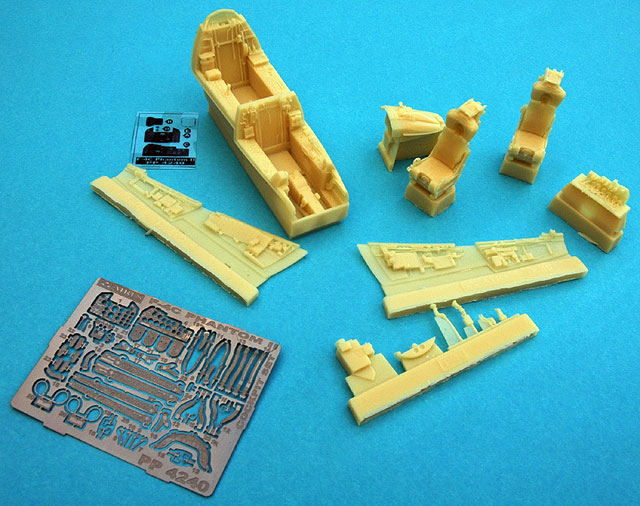|
|
S u m m a r
y |
|
Catalogue Number and Description |
Aires Hobby
Models 4240 - F-4C Phantom Cockpit for the Hasegawa kit |
| Price: |
USD$31.46 available online from Squadron.com |
| Scale: |
1/48 |
|
Contents and Media: |
Grey coloured
resin, acetate film, photo etched metal |
| Review
Type: |
FirstLook |
|
Advantages: |
Excellent detail and casting;
comprehensive photo-etch; solid packing |
|
Disadvantages: |
No painting
instructions |
|
Recommendation: |
Recommended
|
Reviewed by
Rodger Kelly

Aires' 1/48
scale F-4C Phantom II cockpit set is available online from
Squadron.com
Airies 484240 is for
the F-4C, the first kit in Hasegawa's Phantom family. The F-4C/D kit was
originally issued in the early '80s as kit number P6 but has been
re-released in a number of different guises and "decal versions" in the
subsequent years.
The kit was and still is a beauty. The only downside is that it featured
raised panel lines. Not really a problem in itself, but it is noticeable
if you place it next to the latter issued kits in the Phantom family
that feature engraved panel lines. Another minus point of the kit is
that it has twenty five year old cockpit detail. This new kit from
Airies addresses the latter point.
The kit comprises thirteen resin pieces, a small piece of acetate that
holds printed instruments and a reflector glass for the gun sight, as
well as a photo-etch fret that contains 50 odd pieces. The resin parts
are cast in the familiar yellow/tan colour that we are used to seeing
from Airies.
This set uses the same principle adopted by Aires for all of their F-4
cockpit sets in that parts are minimal with everything cast in one piece
rather than separate, tiny and fiddly details. The good side of this is
that there are fewer parts to prepare whilst the downside is that it is
harder to detail paint the parts.
The casting really is superb and something which we have come to expect
from Airies. The detail is crisp and sharp and will only be truly
appreciated when the parts have been painted and treated to a wash and
dry brushing. The set in the main is cast as a tub with separate
one-piece sidewalls, front and rear instrument panels and seats. The
balance of the resin parts includes front and rear control columns, and
internal parts for the canopies.

Click the thumbnails below to view larger images:
The photo-etch fret is comprehensive. It contains
parts for the canopy rails, instrument panels, and ejection seats
harnesses. The metal used is much like the lead foil you get from
wine bottle. It is soft and easy to work with, a good thing, as it
easy to manipulate and drape the belts and harnesses onto the seats
to make them appear more realistic. It also gives you a chance to
re-fold the parts in case (when!) you goof as it does not have a
"memory" like stainless steel parts do.
Now for the old chestnut - does it fit? A cursory dry-fit of the tub
itself (with taped on sidewalls) into the fuselage of one my
un-built Hasegawa F-4 kits tells me that it is not too wide and the
length looks right. However, you will need to do a fair amount of
work to modify the kit to have it fit properly – enough said! To be
fair, Airies do warn you that "Thinning of the plastic parts and
dry-fitting of the assembly needed!"
A small instruction sheet is included. It carries 'exploded views'
of the suggested assembly sequence as well as a 'parts map' to
assist you in identifying the tiny resin parts.
As with all of the Airies resin cockpit sets, there are no painting
instructions apart from a colour photograph of the painted and
assembled kit on the box top, nothing else is included so you will
need to arm yourself with some reference before commencing the build
– let Google be your friend here!
Accuracy? Heck, it looks like an F-4C cockpit to me. It matches the
pics of F-4C cockpits that I found on the internet reasonably well
but then again, I did not find two pics that were labeled as F-4C
that were the same! Remember, cockpits of military aircraft are in a
constant state of change as electronic equipment is introduced,
refined and modified. I can tell you though that it is different
from their F-4C set and (vastly) different that the kit detail. I
would suspect that it looks close enough!
As for packaging, the resin parts are packed into a zip-loc bag
which is then itself wrapped in a small piece of plastic bubble
wrap. The photo-etch fret and acetate sheet are placed into a
plastic bag containing a piece of thick cardboard to keep them flat.
Both of these are then placed in a flimsy cardboard box.
Nice stuff from Airies.
Recommended.
Thanks to Aires for the
review sample.
Text and Images Copyright © 2005 by
Rodger Kelly
Page Created 17 August, 2005
Last updated 17 August, 2005
Back to HyperScale
Main Page
Back to Reviews Page
|
Home |
What's New |
Features |
Gallery |
Reviews |
Reference |
Forum |
Search